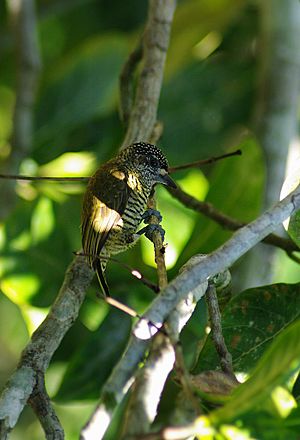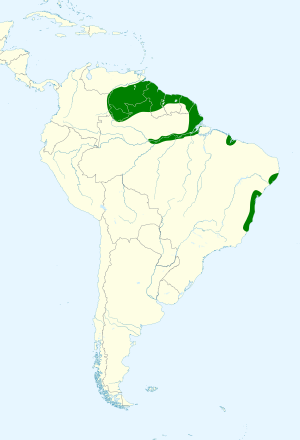Golden-spangled piculet facts for kids
Quick facts for kids Golden-spangled piculet |
|
|---|---|
 |
|
| Conservation status | |
| Scientific classification | |
| Genus: |
Picumnus
|
| Species: |
exilis
|
 |
|
The golden-spangled piculet (Picumnus exilis) is a small bird that belongs to the woodpecker family. It's found in several countries in South America, including Brazil, Colombia, French Guiana, Guyana, Suriname, and Venezuela. These tiny birds are known for their unique looks and how they find food.
Contents
About This Bird
What's in a Name?
Scientists group animals together based on how they are related. This is called taxonomy. For the golden-spangled piculet, different groups of scientists have slightly different ideas about its "subspecies." Subspecies are like different types within the same species.
The International Ornithological Committee (IOC) and BirdLife International say there are six subspecies:
- P. e. clarus
- P. e. undulatus
- P. e. buffonii
- P. e. pernambucensis
- P. e. alegriae
- P. e. exilis (this is the main one, called the "nominate" subspecies)
However, another group, the Clements taxonomy, thinks there are only four. They combine some of the subspecies. For this article, we'll follow the idea that there are six different types.
How to Spot One
The golden-spangled piculet is a tiny bird, usually about 9 to 10 centimeters (3.5 to 4 inches) long. It weighs only about 8.5 to 10 grams (0.3 to 0.35 ounces), which is less than a few paper clips!
Here's what the main subspecies, P. e. exilis, looks like:
- Head: Males have a black cap with red spots on their forehead and white spots on the back of their head. Their face is yellowish-white with dark speckles.
- Body: Their upper body is olive green. Their wings have brownish-green feathers with yellow-green edges.
- Tail: The tail is dark brown, with some white patches on the outer feathers.
- Underparts: Their chin, throat, and belly are pale yellowish with dark, spot-like bars.
- Beak and Legs: The top part of their beak is black, and the bottom part is black with a shiny, silvery base. Their legs are grayish.
Females look almost the same as males, but they have white spots all over their head instead of red and white. Young birds are a bit duller in color and have more blurry bars on their belly.
Different subspecies have small differences in their colors and patterns. For example, P. e. undulatus is more olive green on its upper parts, and P. e. buffonii has special white spots with black edges on its wing feathers.
Where They Live
Golden-spangled piculets live in various types of forests and woodlands. You can find them in:
- Rainforests
- Cloudforests
- Forests that are growing back after being cut down
- Areas with lots of bamboo
- Mangrove swamps
- Open woodlands and the edges of savannas
They can live from sea level all the way up to about 1,900 meters (6,200 feet) high, especially in the tepui region where Venezuela, Guyana, and Brazil meet.
Here's where each subspecies is generally found:
- P. e. clarus: East-central Venezuela
- P. e. undulatus: From eastern Colombia through southeastern Venezuela to western Guyana and northern Brazil
- P. e. buffonii: North of the Amazon River, from eastern Guyana through Suriname and French Guiana to northeastern Brazil
- P. e. pernambucensis: Northeastern Brazil (Pernambuco and Alagoas states)
- P. e. alegriae: Northeastern Brazil, south of the Amazon River
- P. e. exilis: East-central Brazil, from Bahia south to Espírito Santo
Life and Habits
Movement and Home
The golden-spangled piculet doesn't usually migrate. As far as we know, it stays in the same area all year long.
What They Eat
We don't know everything about what the golden-spangled piculet eats, but we do know that ants are a part of its diet. It usually looks for food in the lower parts of the forest, often below 5 meters (16 feet) from the ground. It mostly finds its food on small branches, sometimes even hanging upside down! These birds usually forage alone or in pairs. Sometimes, they might join groups of different bird species that are looking for food together.
Reproduction and Nests
Not much is known about how golden-spangled piculets raise their young. They build their nests by digging a hole in soft wood, like a tree stump. In Venezuela and Suriname, they have been observed nesting between December and March.
Their Song
The song of the golden-spangled piculet has been described as a high-pitched "tsilit, tsirrrr" or a very thin "see see suw."
Conservation Status
The IUCN (International Union for Conservation of Nature) has listed the golden-spangled piculet as a species of Least Concern. This means that it is not currently considered to be in danger of extinction.
Even though it lives across a very large area, we don't know exactly how many of these birds there are. Scientists believe their numbers might be slowly going down. However, no immediate big threats have been found. The bird is not very well studied. It lives in several protected areas, and because it can live in more open or disturbed forests, human activities might even help it spread to new places.
Images for kids
See also
 In Spanish: Carpinterito verdoso para niños
In Spanish: Carpinterito verdoso para niños




